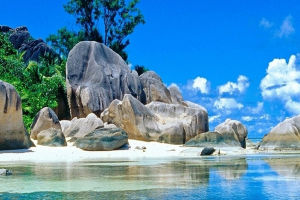Beachrock is a term used in marine geology that refers to rocks formed by the carbonate cementation of sand, gravel, and other debris materials on the beach. The sand layers and shell debris on the intertidal beaches are cemented by calcium carbonate, and these cemented materials are generally high-magnesium calcite and aragonite.
Geologists believe that beach rock is a kind of coastal sedimentary rock found in tropical and subtropical areas, distributed in the beach area. Its formation is related to the regional climate of alternating wet and dry conditions, seawater evaporation, high and low tide cycles, and atmospheric freshwater leaching.
It is a unique marine sedimentary rock formed in a special natural environment. At first glance, it looks like beach sand cemented together and is extremely hard.
Studies have shown that most of the beach rocks seen so far were formed in the Holocene of the Quaternary, approximately 10,000 years ago. The majority of beach rocks were found in the middle and late Holocene of the Quaternary, meaning they formed within the past 6,000 years. Beach rocks older than 10,000 years are rarely reported. In terms of formation time, beach rocks are considered very young rocks.
The minerals in beach rock are mainly composed of quartz and feldspar, while the cement is primarily calcareous, making it very hard. The rock has a sandy and blocky structure, and its most distinguishing feature is the presence of shell fragments, which sets it apart from cement blocks and other rocks.
Due to its mineral composition and cement, beach rock is mainly grayish white, grayish black, and occasionally grayish yellow and light grayish-yellow in color. Compared to other colorful sedimentary rocks, beach rock is relatively monochromatic.
The laminations and undulating interlayers of beach rock are well-defined, and like other sedimentary rocks, geologists can measure its dip angle with a compass. The laminae of beach rocks are remarkable because they always tend to point in the direction of the sea, similar to sunflowers facing the sun.
The inclination of the laminae is typically a few degrees to a dozen degrees, and in some cases, it may reach more than 20 degrees, depending on the topography and the strength of the waves when the beach rock was formed. If the beach rock tends to point in the direction of land or has a nearly upright dip angle, it indicates that external forces such as the rise and fall of the Earth's crust or earthquakes have altered the beach rock in that location.
Beach rocks were formed in the intertidal zone, where hydrodynamic conditions were very strong, and they were subjected to weathering and erosion by external forces such as waves and organisms during and after the rock formation period.
The thickness of the present rock layer represents the residual thickness after weathering. Seawater and sea wind erosion have created geomorphic features such as sea caves, sea towers, sea bridges, and sea sails on the beach rock. These peculiar geomorphic landscapes can be observed, for example, in the Luhuitou Scenic Area in Sanya City, Hainan Province.
Beachrock is primarily composed of two major components: granite gravel debris of land origin and marine biological debris, with calcareous cementation. Although the rock formation time is short, the degree of rock formation is significant.
The rock is harder than cement blocks and not easily broken when hammered. Residents living near Beachrock directly cut blocks from it to use as building materials for houses. Surprisingly, beach rock can also be processed into animal feed. Some types of beach rock contain a high percentage of shell fragments, exceeding 90%.
There is a type of beach rock that contains a large amount of shell fragments, exceeding 90%. The mineral powder processed from this particular beach rock is rich in calcium and also contains organic matter, phosphorus, potassium, and other elements. All of these components are beneficial for the growth and development of animals, making it suitable for use as animal feed.
Beach rock not only possesses a unique appearance and forms in an unusual environment but also serves as a record of nature's changes. It is a treasure bestowed upon mankind by nature, waiting for us to unveil its mysteries in the future.


